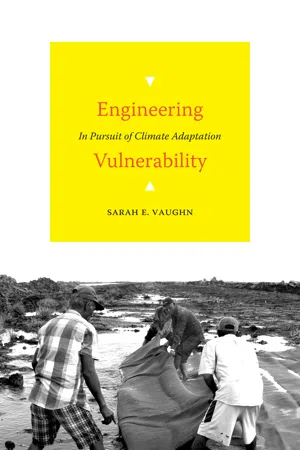
- English
- PDF
- Available on iOS & Android
eBook - PDF
About this book
In Engineering Vulnerability Sarah E. Vaughn examines climate adaptation against the backdrop of ongoing processes of settler colonialism and the global climate change initiatives that seek to intervene in the lives of the world's most vulnerable. Her case study is Guyana in the aftermath of the 2005 catastrophic flooding that ravaged the country's Atlantic coastal plain. The country's ensuing engineering projects reveal the contingencies of climate adaptation and the capacity of flooding to shape Guyanese expectations about racial (in)equality. Analyzing the coproduction of race and vulnerability, Vaughn details why climate adaptation has implications for how we understand the past and the continued human settlement of a place. Such understandings become particularly apparent not only through experts' and ordinary citizens' disputes over resources but in their attention to the ethical practice of technoscience over time. Approaching climate adaptation this way, Vaughn exposes the generative openings as well as gaps in racial thinking for theorizing climate action, environmental justice, and, more broadly, future life on a warming planet.
Duke University Press Scholars of Color First Book Award recipient
Duke University Press Scholars of Color First Book Award recipient
Frequently asked questions
Yes, you can cancel anytime from the Subscription tab in your account settings on the Perlego website. Your subscription will stay active until the end of your current billing period. Learn how to cancel your subscription.
At the moment all of our mobile-responsive ePub books are available to download via the app. Most of our PDFs are also available to download and we're working on making the final remaining ones downloadable now. Learn more here.
Perlego offers two plans: Essential and Complete
- Essential is ideal for learners and professionals who enjoy exploring a wide range of subjects. Access the Essential Library with 800,000+ trusted titles and best-sellers across business, personal growth, and the humanities. Includes unlimited reading time and Standard Read Aloud voice.
- Complete: Perfect for advanced learners and researchers needing full, unrestricted access. Unlock 1.4M+ books across hundreds of subjects, including academic and specialized titles. The Complete Plan also includes advanced features like Premium Read Aloud and Research Assistant.
We are an online textbook subscription service, where you can get access to an entire online library for less than the price of a single book per month. With over 1 million books across 1000+ topics, we’ve got you covered! Learn more here.
Look out for the read-aloud symbol on your next book to see if you can listen to it. The read-aloud tool reads text aloud for you, highlighting the text as it is being read. You can pause it, speed it up and slow it down. Learn more here.
Yes! You can use the Perlego app on both iOS or Android devices to read anytime, anywhere — even offline. Perfect for commutes or when you’re on the go.
Please note we cannot support devices running on iOS 13 and Android 7 or earlier. Learn more about using the app.
Please note we cannot support devices running on iOS 13 and Android 7 or earlier. Learn more about using the app.
Yes, you can access Engineering Vulnerability by Sarah E. Vaughn in PDF and/or ePUB format, as well as other popular books in Biological Sciences & Latin American & Caribbean History. We have over one million books available in our catalogue for you to explore.
Information
Publisher
Duke University Press BooksYear
2022Print ISBN
9781478018100, 9781478015482eBook ISBN
9781478022725Table of contents
- Cover
- Contents
- Abbreviations
- Technical Notes
- Acknowledgments
- Introduction: “Where Would I Go? There Was No Place with No Water
- 1. Disaster Evidence
- 2. The Racial Politics of Settlers
- 3. Engineering, Archives, and Experts
- 4. Compensation and Resettlement
- 5. Love Stories
- 6. Accountability and the Militarization of Technoscience
- 7. The Ordinary
- Conclusion: Materializing Race and Climate Change
- Notes
- References
- Index